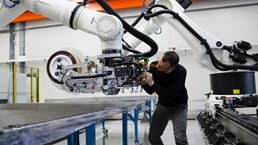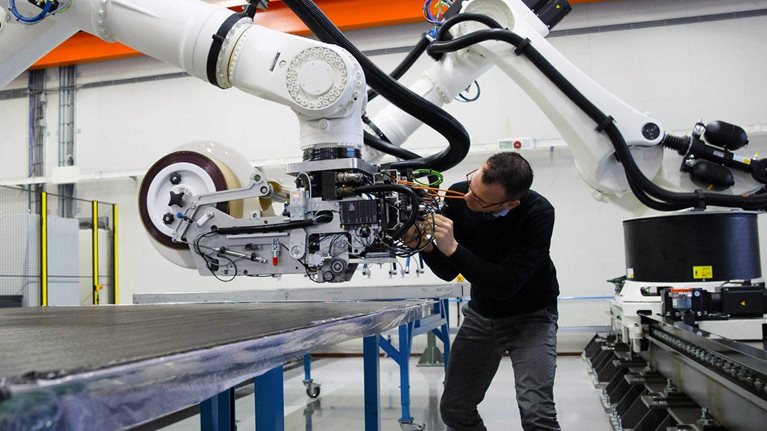Organizations in every region and industry are automating at least some business processes, yet only a slight majority have succeeded at meeting their targets, according to a new McKinsey Global Survey on the topic.1 As advances in artificial intelligence, software robotics, machine learning, and innovative technology platforms enable businesses to redefine processes, workplace automation is expected to provide a significant opportunity for improvements in performance and efficiency.2 Indeed, three-quarters of all respondents say their companies have already begun to automate business processes or plan to do so within the next year. The results also suggest which practices best support a successful automation effort: making automation a strategic priority, deploying technologies systematically, decentralizing governance, ensuring the IT function’s involvement, internalizing automation’s costs and benefits, and prioritizing workforce management.
Automation, a global phenomenon
Across regions and industries, the survey results suggest that automating businesses is a global phenomenon (Exhibit 1). A majority of all respondents (57 percent) say their organizations are at least piloting the automation of processes in one or more business units or functions. Another 38 percent say their organizations have not begun to automate business processes, but nearly half of them say their organizations plan to do so within the next year.3 Across regions, respondents in developing markets are just as likely as their peers to report automation activity.

Not surprisingly, the high-tech and telecom industries are leading the way on automation. Three-quarters of respondents in those sectors say they are at least piloting automation in one or more business units or functions. Nonetheless, the results suggest that all industries have been or expect to be deploying automation technologies. At least half of respondents in all other industries say their companies have already begun to pilot or adopt automation.
The results also suggest that larger organizations are leading smaller ones in pursuing automation.4 Among respondents at large companies, 40 percent say theirs are using automation across the organization or have fully automated processes in at least one function or business unit. At smaller organizations, just 25 percent say the same.
The factors of automation success
Although automation has become commonplace, the results indicate that success is by no means assured. We looked closely at the responses from larger organizations, where automation is more prevalent. Across industries, more than half of large-company respondents say their organizations have seen success to date (that is, their automation efforts have been successful or very successful at meeting targets). The results also point to six practices that the most successful companies tend to employ.
Make automation a strategic priority
According to respondents, organizations with successful automation efforts are more likely than others to designate automation as a strategic priority. When asked about their companies’ primary reasons for adopting automation technologies, these respondents are more likely than others to say automation was defined as a priority during the strategic-planning processes or is required to keep pace with competitors (Exhibit 2).

Deploy automation technologies systematically
While automation success is possible through either traditional top-down (waterfall) deployment or more flexible agile methods, a systematic approach is key. Only 5 percent of respondents at successful companies say their deployment methods have been ad hoc, compared with 19 percent of peers not reporting success (Exhibit 3).

What’s more, successful organizations are implementing different automation technologies from the ones other organizations are adopting. Respondents with successful automation efforts are more than twice as likely as others to say their organizations are deploying machine learning (Exhibit 4). They are also more likely to cite the use of other cognitive-based automation capabilities, such as cognitive agents and natural-language processing. At respondents’ organizations overall, the most commonly adopted automation technology is robotic process automation, which respondents say is deployed in equal shares of successful and other organizations.

Decentralize governance
Another differentiator of automation success, the results suggest, is the way programs are organized. The results favor decentralization. Respondents at successful organizations are more likely than their peers to say their functions or business units are accountable for delivering automation efforts, with or without support from a central team. Conversely, respondents at less successful organizations are more than twice as likely as those at successful ones to say a central team is solely responsible for automation delivery across the organization.
Would you like to learn more about our Operations Practice?
Ensure the IT function’s involvement
The success of automation programs also relies on the early engagement of the IT function, according to respondents from organizations with successful efforts. First, these organizations’ IT teams are more likely to have automated their own processes.5 Furthermore, IT’s involvement in the automation effort also is a differentiator of success. More than 75 percent of respondents from successful organizations say IT was involved in initial discussions of automation projects, compared with 58 percent of all other respondents (Exhibit 5). By contrast, just 13 percent of respondents who consider their automation efforts successful say IT was not brought onboard until pilots were already under way.

Internalize both costs and benefits
Successful and less successful automation efforts also diverge in regard to management’s understanding of the total cost of ownership (TCO).6 Half of respondents with successful automation efforts say their leaders understand very well the TCO for automation projects. Only 7 percent of peers at other organizations say the same. That said, respondents report similar benefits from their automation efforts, regardless of their success to date at meeting targets. The most common benefit reported is reduced costs, identified by about one-third of all respondents.
Prioritize workforce management

Among all large organizations reported to be pursuing automation, a majority of respondents predict that their companies will face automation-related skill gaps in the future. Only 8 percent believe there will be no gaps to address. And while most respondents say addressing potential automation-related skill gaps is a top ten priority for their organizations, respondents at successful organizations are more than three times likelier than others to consider the effort a top five priority (Exhibit 6).
What’s more, organizations with successful automation efforts are more likely than others to report concerns about talent acquisition. They are five times likelier (40 percent, compared with 8 percent) to say acquiring employees with the right skills will be their organizations’ most significant automation-related challenge in the next three years.
What success looks like at small companies
Smaller companies are less likely than larger companies to automate processes, but their success rate is higher. The findings from these organizations show that several differentiators for success hold true regardless of company size.
As with large companies, IT’s involvement in small companies’ automation efforts is greater at successful companies. More than 80 percent of respondents at successful small companies say their IT functions were involved in the initial discussion phase of planning for automation projects, compared with two-thirds of respondents at other small companies. And 64 percent of respondents from successful small companies report the automation of at least one business process in IT, compared with 41 percent of their small-company peers.

Harnessing automation for a future that works
Understanding costs also is a marker of success at smaller firms. At successful small companies, nearly half of respondents say their leaders understand the total cost of ownership of automation efforts very well or completely, while only 28 percent of respondents from other companies say the same. The findings also suggest that automation-related talent management is top of mind for leaders at successful small companies. And like their large-company peers, respondents from the most successful small companies are likelier than others to say that addressing potential automation-related skill gaps is at least a top ten priority for their organizations.
Looking ahead
The findings from this survey can be applied to organizations at all stages of the automation journey. Depending on an organization’s current state, its leaders can take several steps to reap the rewards of automation.
- Prioritize automation. Organizations that are just launching automation programs would benefit from making automation a strategic priority from the outset. Ways to put this in action include defining clear strategic objectives for automation, having an executive sponsor for the program, beginning automation work with a comprehensive understanding of both the costs and benefits, and making automation an enterprise-wide, rather than functional, mandate.
- Focus on roles and people. Organizations that are struggling to implement automation successfully would do well to elevate the role of IT—for example, involving the function often and as early as possible in all future efforts. These organizations also should take a discerning look at workforce management. This includes development of an approach to capture value from automation and an assessment of the skills and new roles for the workforce that accompany future-state automated processes.
- Expand ownership and adoption. Finally, organizations that are successfully deploying automation technologies should also look to expand the governance of and buy-in on automation. They can benefit from encouraging a truly enterprise-wide program and pursuing more advanced cognitive automation technologies. Structuring automation programs to be technology neutral will allow organizations to keep pace with the rapid advances being made, rather than rethinking their approach every time they adopt a new technology.


